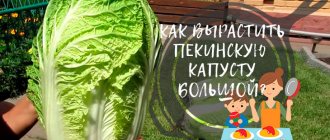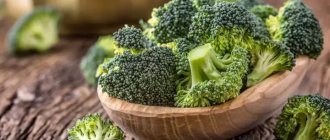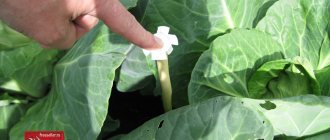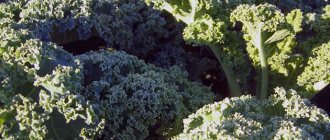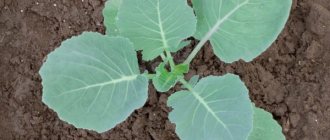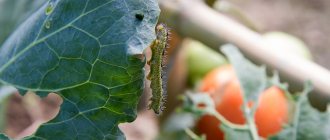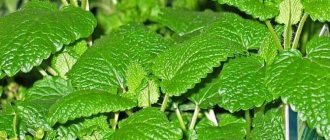Every vegetable grower must know when to remove cabbage from the garden. Strict adherence to the timing of harvesting a ripe crop will significantly increase the shelf life of mid-season and late varieties. In addition, timely harvesting will prevent cracking of the heads, which many varieties of cabbage are susceptible to when the crop is stored for too long.
What factors determine the timing of harvesting?
Quite a lot of factors influence when exactly to harvest cabbage. The main ones are the climatic conditions of the growing region and the ripening time of a particular variety.
Climatic conditions
Climate plays a fairly large role in the cabbage ripening process. This culture loves damp, cool weather. Accordingly, if the summer was just like this, then heads of cabbage will form on the bushes in the shortest possible time and the vegetable will quickly ripen. If dryness and intense heat were observed in the summer, the growth of the crop will stop and the harvest will have to wait longer.
The type of climate also affects the time of planting seedlings in open soil. So, in the southern regions, planting is carried out already in May. To the north, there may still be severe frosts at this time, so sowing seeds and transferring seedlings to the beds is postponed. Accordingly, the ripening of the heads in this case occurs later. In different climatic zones, the difference in the ripening time of the same variety can reach up to a month.
Variety ripening period
Each variety of cabbage has a different growing season. This factor also influences the determination of the exact timing of cabbage harvesting. In accordance with the duration of plant development, all varieties are divided into three types:
- Early cabbage.
- Mid-season varieties.
- Late varieties.
For early cabbage to ripen, it takes approximately 90–100 days from the moment the seeds are sown in the soil. As a rule, the harvesting time falls between mid-July and early August. Early types are not suitable for storage. In addition, harvesting such a crop cannot be delayed, since the heads quickly crack after ripening.
Mid-ripening and late varieties ripen in 130–150 days. Preserving this type of cabbage is much easier. In addition, it is suitable for fermentation. Mature forks are collected in the last ten days of September and early October.
Cabbage collection by type, timing and approximate dates
Despite the fact that twenty years ago most gardeners grew only white cabbage, modern gardeners pay special attention to planting different species of the cabbage family. Seeds of Brussels sprouts, kohlrabi, cauliflower, broccoli and red cabbage species are increasingly found in home gardens.
Harvesting cabbage by variety:
1) The Savoy variety has always been distinguished by its excellent taste, increased value and abundance of juice. Harvesting for storage begins in mid-September, completing collection in the second half of October. The growing season ranges from 110 to 130 days.
2) Colored, used for consumption after heat treatment. It is used for preparing salads, light snacks and warm salads. The growing season is long, taking more than 115 days.
3) Brussels sprouts are one of the healthiest varieties of cabbage. Many scientists have repeatedly spoken about the need for its use in the daily diet of adults and children. Cabbage is harvested in the autumn months, taking into account the time of planting and the growing season as a whole.
4) Kohlrabi, a new variety for most gardeners, which appeared in the regions not so long ago. Heads of cabbage are harvested in the autumn months, when the temperature drops from 0 to 4 degrees Celsius.
5) Broccoli is one of the best cabbage foods to eat in your daily diet. Pruning is carried out with the onset of cold weather, approximately 3.5-5 months after planting. Only the tops are cut off from the garden bed, leaving the lower part untouched.
6) Beijing or Beijing, is one of the early ripening varieties that ripen in an open garden from the beginning of July until mid-October. 90-110 days is the optimal growing season to obtain mature heads of cabbage filled with vitamins, macro- and microelements.
7) Closing the list of varieties is red cabbage, which remains popular after white cabbage in first place. Collection takes place from the beginning of September until the first frost.
White cabbage
White cabbage is the most common type of cabbage, divided, depending on the timing of ripening, into:
- early ripening,
- mid-late,
- late ripening.
The timing of harvesting all varieties of cabbage depends on the quality and quantity of fertilizing. With proper nutrition, plants get a jumpstart in development and ripen 10-15 days earlier. Cultivation of early cabbage should be carried out in such a way as to obtain a harvest in the earliest possible time (May 20-30).
In addition, by using seedlings instead of seeds, it is possible to obtain earlier production due to accelerated development during the period of plant formation.
When to remove white cabbage from the garden in the fall?
In the conditions of the south of the Russian Federation, early-ripening varieties are harvested on May 25-30, mid-late ones - on the 1st-2nd decade of July, late-ripening varieties - on the 2nd-3rd decade of July or 1st decade of August.
For the Leningrad region, the timing is somewhat different. Here, early cabbage ripens only by the end of June - early July, mid-late varieties - 1 decade - 3 decade of August, and late ripening - 1-2 decades of September.
In the conditions of central Russia (for example, the Moscow region), white cabbage should be harvested in the fall already in the 3rd ten days of September - 1st ten days of October (mid-late varieties), early varieties ripen, respectively, somewhat earlier - 2-3 ten days of September. Late-ripening cabbage arrives in the 2-3rd decade of October.
In Siberia and the Urals, white cabbage ripens by the end of September - beginning of October.
The harvesting period for cabbage in Ukraine (except for the south) corresponds to the central zone of the Russian Federation. In Belarus, cabbage is harvested at the end of September – beginning of October.
Cabbage depending on the purpose of cultivation
- It is customary to grow early products for sale,
- mid-late - for sale,
- later - for storage.
It is customary to take mid-late varieties for processing; as a rule, they are best suited for making pickles, marinades and various kinds of canned food.
It should be remembered that not every head of cabbage is suitable for long-term storage. Heads of cabbage weighing at least 400 g, peeled to tight-fitting green or white leaves, are placed for storage.
Heads of cabbage stored for storage should not be affected by diseases or pests. Harvesting is carried out selectively two or three times, every 5-7 days, as they ripen. Weight of heads of cabbage during harvesting in the southern zone of the Russian Federation:
- before July 1 must exceed 300 g,
- after July 1 – 400.
The heads of cabbage are cut off along with several leaves and placed in boxes.
When to harvest cabbage from the garden for storage for the winter according to the lunar calendar
Gardeners who attach great importance to the lunar phases, sowing and harvesting according to the calendar, can confirm that if the recommendations are followed, cabbage is stored much longer, and its taste is higher. Therefore, you should be guided by the information from the table and plan your work only for favorable periods.
| Month | Favorable dates |
| July | From 4 to 8, 14–16, from 20 to 22 |
| August | 1, 2 and 4, from 10 to 12, 13–14, from 27 to 29, 31 |
| September | 3–8, from 13 to 16, from 23 to 28 |
| October | From 2 to 5, from 11 to 14, 28–31 |
| November | From 1 to 10, 18–25, from 25 to 30 |
Cauliflower
The timing of harvesting cauliflower depends on the diameter of the heads, which should reach 7-8 cm. If grown in the summer-autumn period, not all plants have time to form heads. They should be grown in small greenhouses, if available, or in other premises if not.
The harvesting time for early-ripening varieties in the southern Russian Federation is 1-2 decades of July, for mid-late varieties - 1-2 decades of August, late-ripening varieties - 2-3 decades of August.
In central Russia, depending on the variety, cauliflower ripens from early August to late September.
In Siberia, cauliflower is grown only in greenhouses and greenhouses.
In Ukraine and Belarus, the timing of ripening and harvesting of cauliflower is similar to that of central Russia. Cauliflower is not suitable for long-term storage at home due to its biological characteristics - it can be stored for no more than 10 days (at a temperature of 0.5 to 0 degrees Celsius). The timing of harvesting cabbage from the garden also depends on the breaking of leaves, since in the absence of this agrotechnical technique, harvesting is postponed by 3-7 days, and the quality of the product is noticeably reduced.
Where is the best place to put it?
There are a sufficient number of places where you can store cut heads of cabbage:
- A basement or cellar is an ideal place with optimal storage conditions for the harvested crop. Before storing, the heads of cabbage are dried and wrapped in several layers of newsprint. It is convenient to store cabbage in the basement in a suspended state. To do this, the heads of cabbage are tied in pairs and hung on a crossbar.
A pantry is a good place for storage, provided that it maintains the required air temperature level (from 0 to + 3 ° C).
Before storing food, you need to make sure that there is no mold on the walls of the pantry. The heads of cabbage are wrapped in parchment and laid out in a pyramid (stalks up) in the darkest corner.- A balcony for storing cabbage is only suitable if it is insulated and in winter the air temperature in the room does not drop below -4°C. The heads of cabbage are laid out in lattice wooden or plastic boxes with the stalks inward.
- In a refrigerator . A small cabbage harvest can be stored in a regular refrigerator. Each head of cabbage is wrapped in cling film and placed in the vegetable compartment. Periodically, cabbage is checked for the presence of areas of rot and mold.
If there is no cellar or free space on the balcony, the harvest can be stored in a garden pit. A layer of straw is laid on the bottom, on which the heads of cabbage are placed in one row. The top of the cabbage is covered with straw and a thick tarpaulin.
Broccoli
For faster ripening of broccoli cabbage, it is necessary to treat it with ammonium nitrate (100 kg per 1 ha), in this case it becomes possible to obtain a second harvest due to side shoots.
Broccoli is harvested selectively, from the end of August to the end of September (southern Russia), depending on the ripeness of the central heads (in this case, it is advisable to grow broccoli as seedlings).
In the conditions of the north of Russia (Ural, Siberia), broccoli cabbage is very limited in distribution. This is due to the heat-loving nature of this crop.
It should be remembered that without refrigerated storage, the shelf life of broccoli should not exceed 7 days.
How to tell if cabbage is ripe
When the vegetable reaches a size corresponding to the varietal characteristics, its development stops.
Signs of ripeness of a head of cabbage:
- the fork becomes dense with a smooth and shiny surface, a light spot appears on the top of the head of cabbage;
- the leaves of the vegetable acquire a characteristic crunchiness;
- yellowing and sagging of the lower leaf plates are observed, which indicates a redistribution of nutrients at the end of the growing season (not to be confused with the development of vascular bacteriosis);
- The covering leaves of the head of cabbage acquire a bluish tint and are covered with a bluish coating.
To achieve maximum concentration of nutrients and vitamins in the heads of cabbage, stop watering the crop 2 weeks before harvesting. Prolonged precipitation can interfere with this process. In this case, temporary film shelters are built over the cabbage beds.
Spraying cabbage with a 1% boric acid solution a week before harvest extends the shelf life of the heads of cabbage. The antiseptic prevents the development of pathogenic microorganisms - fungi and bacteria that cause vegetable rotting.
Red cabbage
Red cabbage, depending on the timing of planting, is harvested in several ways:
- before winter (in November) in the conditions of the south of Russia - in a continuous way,
- planted in the spring, in June and July - selectively, as the heads of cabbage and heads of cabbage ripen.
Ripeness is determined by density (the heads of cabbage do not compress when pressed, are firm, have four adjacent leaves), and have a characteristic color.
When storing for the winter, the heads of cabbage should be dense and juicy and should be harvested a little earlier than for fresh consumption. The difference in timing for products harvested for canning and storage and for fresh consumption is one and a half to two weeks.
In order for the heads of cabbage to be dense and juicy, it is necessary to water the cabbage generously periodically, once every two to three days. In extreme heat, to avoid cracking of the heads of cabbage - once every two days.
In the conditions of central Russia, cabbage planted in the spring is harvested in the fall, in late September - early October. In the conditions of Siberia and the Urals, cabbage is harvested in August-September.
Recommendations for storing crops
To preserve the qualities of a leafy vegetable for a long time, it is necessary to comply with the conditions. The best place for laying cabbage is a relatively dry and cool room - a cellar, pantry, or insulated shed. To prevent the crop from being damaged by third-party fungi or bacteria, it is necessary to carry out disinfection since the summer - whitewashing surfaces with quicklime, treating with copper sulfate or fumigating with sulfur. It is better to store cabbage in compliance with the following standards:
- Regular ventilation or equipped ventilation (natural or automated).
- Humidity inside a cellar or other room should be present, but without condensation on surfaces.
- Normal storage temperature should be between 0ºC and +5ºC. In case of possible frosts, you can cover with polyethylene.
Attention!
If the temperature in the room with cabbage rises above +8ºC, then there is a risk of rotting. In such cases, you need to inspect all plugs, remove any damaged ones and ventilate the room.
Savoy cabbage
Savoy cabbage has high frost resistance, so in central Russia it can be harvested in late autumn (November 20-25).
Moreover, frosts of –7-8 °C have a beneficial effect on the taste of savoy cabbage. By the time of harvesting, the heads of cabbage should be fresh, clean, healthy, not sprouted, of varying density. Store cabbage at a temperature of 0-1°C.
Adviсe
It is important to adhere to the following recommendations:
- You cannot leave cut heads of cabbage in the garden at sub-zero temperatures. The cabbage will freeze, after thawing it will lose its taste and spoil very quickly.
- If during the harvest period the air temperature drops below 0°C, the still uncut heads should be left in the garden. You can cut them off when the air warms up and the plugs thaw.
- Do not delay the cabbage harvest. At a temperature of -6°C, the heads of cabbage freeze, which leads to rapid spoilage of the product.
- To prevent the cut heads from losing their juiciness during storage, several protective leaves are left on them.
- When storing cabbage in a basement or cellar, you need to make sure that there are no boxes of vegetables or fruits with a strong smell nearby.
- Stocks should be checked periodically for the presence of rotten heads of cabbage. Otherwise, one rotten vegetable can cause damage to almost the entire crop.
This article will tell you at what temperature fresh cabbage should be stored in winter. Read all the most important things about storing cabbage here.
Brussels sprouts
Harvesting of Brussels sprouts begins as soon as the heads of cabbage, having reached small sizes, acquire a characteristic shine, and the two or three lower leaves turn yellow. They should be cut off.
If we talk about specific dates, then in the south of the Russian Federation this is the middle - end of August, and in the conditions of central Russia - the second half of September, starting from the 15th to the end of the month; in the Urals and Siberia, cabbage ripens by the end of September-beginning of October.
Being cold-resistant, Brussels sprouts tolerate short-term temperature drops to –8-10 °C. If it is necessary to store the plants for winter storage, plant them whole, removing the leaves.
Are you afraid of frost?
Is white cabbage afraid of frost? White cabbage is not afraid of the first frosts , but there is still no need to delay harvesting. The longer the heads of cabbage lie in the cold, the worse they will be stored.
If a person does not have time to cut down all the cabbage before the temperature drops below -5 degrees, then it can quickly spoil .
Such heads of cabbage will have to be put into use immediately - frozen or fermented. In its entirety, it will not last more than a month. And if you harvest late cabbage too early , the leaves will begin to wither and will also not allow the harvest to last all winter.
Find out about the timing of harvesting Brussels sprouts, cauliflower and kohlrabi from our articles.
Kohlrabi cabbage
Kohlrabi is removed from the garden in the summer as the stem fruit ripens, which is cut off when it reaches a diameter of 6-7 cm. It is better not to delay the collection - after that the fruits begin to coarse, lose their juiciness and taste. During the season, up to three cuts are obtained - harvests of kohlrabi cabbage.
Kohlrabi is harvested in dry, sunny weather; humidity is not of fundamental importance, but it should be remembered that if you harvest vegetables in the rain, you risk greatly reducing their shelf life.
When is the best time to remove cabbage for pickling?
Different periods are suitable for fermenting vegetables. You can use an early ripening variety for this purpose, but then the resulting dish will need to be stored under special conditions. But it is worth considering that in this case, sauerkraut will have a different taste from the traditional one, and it will also contain fewer vitamins, antioxidants and other useful components.
The ideal variety for pickling is late-ripening. It begins to ripen approximately 4 months after sowing. This time is enough for the vegetable to accumulate large quantities of useful microelements, become juicy, and the bitterness disappears. In addition, these varieties ferment well and have a long shelf life.
Harvesting rules
In addition to strict adherence to harvesting deadlines, the duration of storage of heads of cabbage is also affected by the quality of this procedure. When harvesting cabbage, you should follow these recommendations:
- 2 weeks before the planned harvest, watering the crop is completely stopped.
- Cut the heads on a sunny day without precipitation. In this case, immediately after harvesting, the heads of cabbage are placed outside on a wooden pallet to dry.
- When cutting off the forks, another 3–4 cm of stump is left on the head. At the same time, the covering leaves are also preserved, removing them just before transferring them to a permanent storage location.
- During operation, the heads must not be thrown, hit against each other, or damaged by the tool. All this significantly reduces the shelf life of forks.
- The crop should not be left to dry even with minimal frost. A temperature of -1 degree is enough for areas of rotting to form at the cut points and inside the head.
Important! After harvesting, all heads of cabbage must be sorted. Only those forks that are dense and free from damage and signs of disease are allowed for storage. All heads that do not meet the standard are consumed immediately.
Proper storage of cabbage is the key to good shelf life
Placement for storage - after harvesting and sorting, the cabbage is immediately put away for storage. You can wrap the forks in newspapers or other paper, this will prevent the forks from touching each other and reduce the risk of rot spreading. Do not allow the paper to get wet, which leads to rapid deterioration. When using newspaper, you need to remember that printing ink may contain harmful substances and when eating a vegetable, you need to remove the top leaves. Selected fruits are placed for storage, which is done in several ways:
storing cabbage in a box - in the photo
- Wooden boxes made from nailed together boards. In this case, the forks come into contact, preventing ventilation and promoting the spread of spoilage, so this method is not considered the most reliable, but when the harvest is too large and there is nothing at hand except the boxes, then you can store it this way. The main thing is to check the forks for rot from time to time, removing spoiled ones;
- Pyramid – the cabbage is stacked in a pyramid shape, loosely in a checkerboard pattern, rather than just piled in a heap. This method minimizes the contact of heads of cabbage with each other and facilitates ventilation, but if the lower head of cabbage is damaged, the entire structure will have to be disassembled;
- Shelves - cabbage is simply placed on shelves with the stalks up, which makes it easier to monitor the condition and ventilation, but requires a lot of space;
- Hanging – Leaving a long root after digging makes it easy to hang the plugs from hooks or tied ropes. This method is especially good if the ceilings in the basement are high enough, and also frees up shelves and drawers for other vegetables.
When to harvest white cabbage for winter storage depends on a number of factors, the observance of which will help preserve the harvest for a long time and ensure the preservation of vitamins and other useful nutrients in which this vegetable is so rich and valuable. Other varieties of cabbage have their own characteristics of harvesting and storage.
Equipment for harvesting cabbage
The list of tools necessary for harvesting cabbage plantations is quite simple. To work, the gardener will need:
- a sharp knife used to cut the stump;
- a shovel used to dig up the fork with the roots, if this provides for the chosen method of storing vegetables;
- wheelbarrow for transporting crops.
Important! When collecting cabbage in remote fields, you will also need a car for transportation.
How to remove from the garden correctly?
It is possible to preserve the integrity of the cabbage head, and at the same time ensure the longest storage period for the crop, provided that certain harvesting rules are observed:
- Heads of cabbage are cut only in dry weather. Wet leaves begin to rot very quickly, so if it rains during the harvesting process, before storing the cabbage, it must be thoroughly dried outside under a canopy.
- Ten days before the start of harvesting, watering the cabbage beds is stopped.
- The heads of cabbage are cut down with a hatchet or cut with a very sharp knife. A sharp fork will be required to dig up the roots. During the cutting process, it is important to ensure that the stalk length remains at least 5 cm.
- If the soil in the garden is loose, the heads of cabbage are twisted out along with the roots.
- When cutting cabbage, be sure to leave three outer leaves. They will protect the head from damage, rot, fungi and mold.
- Insufficiently formed, rotten and other “defective” heads of cabbage are immediately sorted and set aside. They are not suitable for long-term storage.
If cabbage was grown in soil saturated with nitrogen-containing fertilizers, the crop also cannot be stored for long periods of time. It is immediately recycled.
Common problems when storing crops
When storing cabbage, difficulties often arise - the forks can rot. This problem occurs due to violations of general conditions or improper preparation of the vegetable. When stacking cabbage forks, be sure to cull them - any heads with mechanical damage or signs of disease cannot be placed in the main stock. They can be used for processing - fermenting or preparing any dish. If all preparation procedures are carried out in compliance with the rules, and storage standards comply, then you need to look for the reasons for cabbage spoilage in diseases of this crop:
- Gray mold is a severe disease with rapid spread. A dusty coating appears on the heads of cabbage and there is a moldy smell. Damaged leafy vegetables should be removed immediately after the problem is identified.
- Mucous bacteriosis - manifests itself in the form of mucus with a pronounced unpleasant odor. The decomposition process rapidly spreads inside the leafy vegetable. Affected forks must be thrown away.
- Fusarium is a fungal infection of cabbage that causes gradual wilting due to blockage of the ducts. Dark dots are visible on the cross section. Forks affected by fusarium are not suitable for storage.
Attention!
Diseases that lead cabbage to such conditions often occur when cultivation conditions are violated. To avoid such problems, you need to apply fertilizing in a timely manner and monitor the general condition of leafy vegetables in the garden.
Meeting the deadlines for harvesting cabbage is an equally important factor for long-term storage of the leafy vegetable or its salting. To determine the appropriate harvest period, it is necessary to take into account not only the variety, but also regional climatic features. Gardeners also recommend taking into account the dates indicated in the lunar calendar as favorable and unfavorable. But this is not enough to preserve the harvest - the conditions must be met and preliminary screening of unsuitable heads of cabbage must be carried out.




